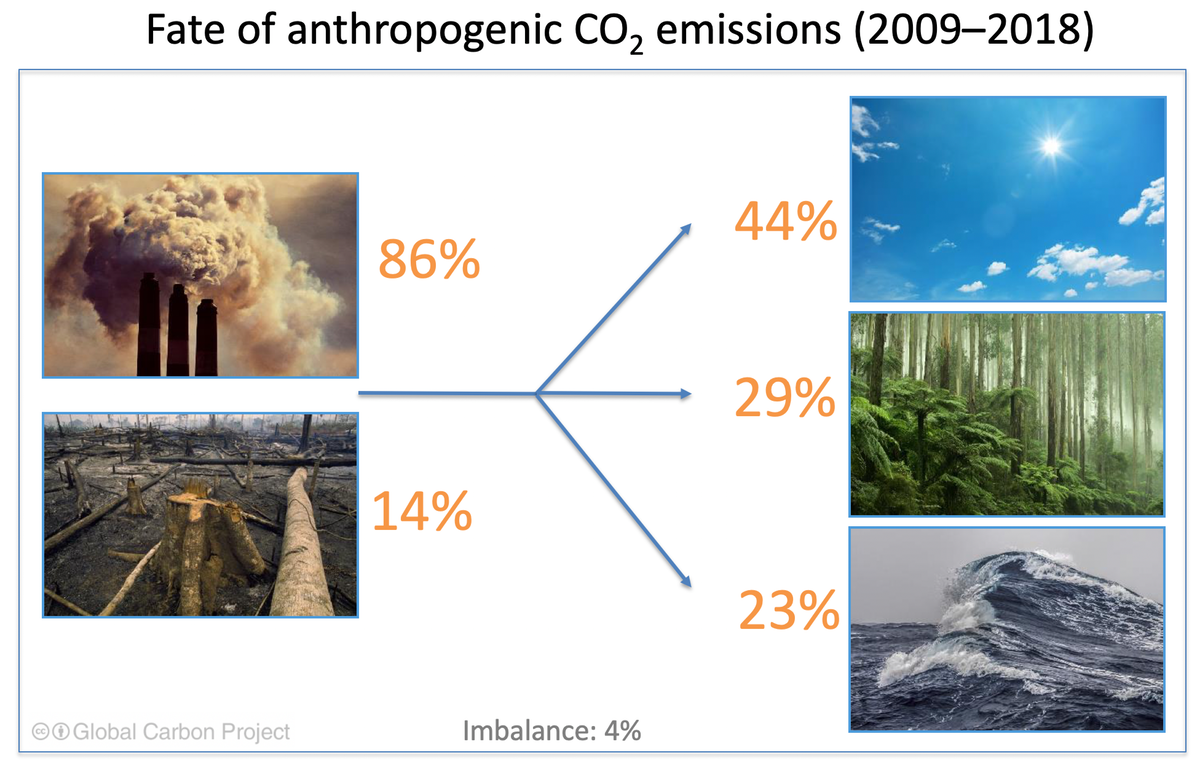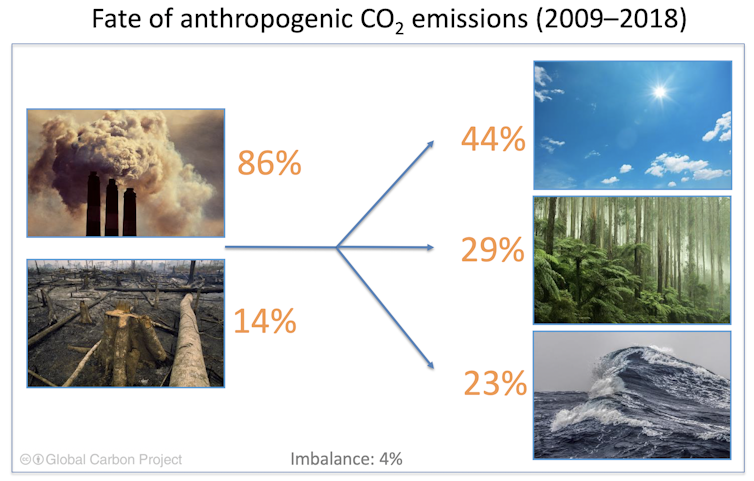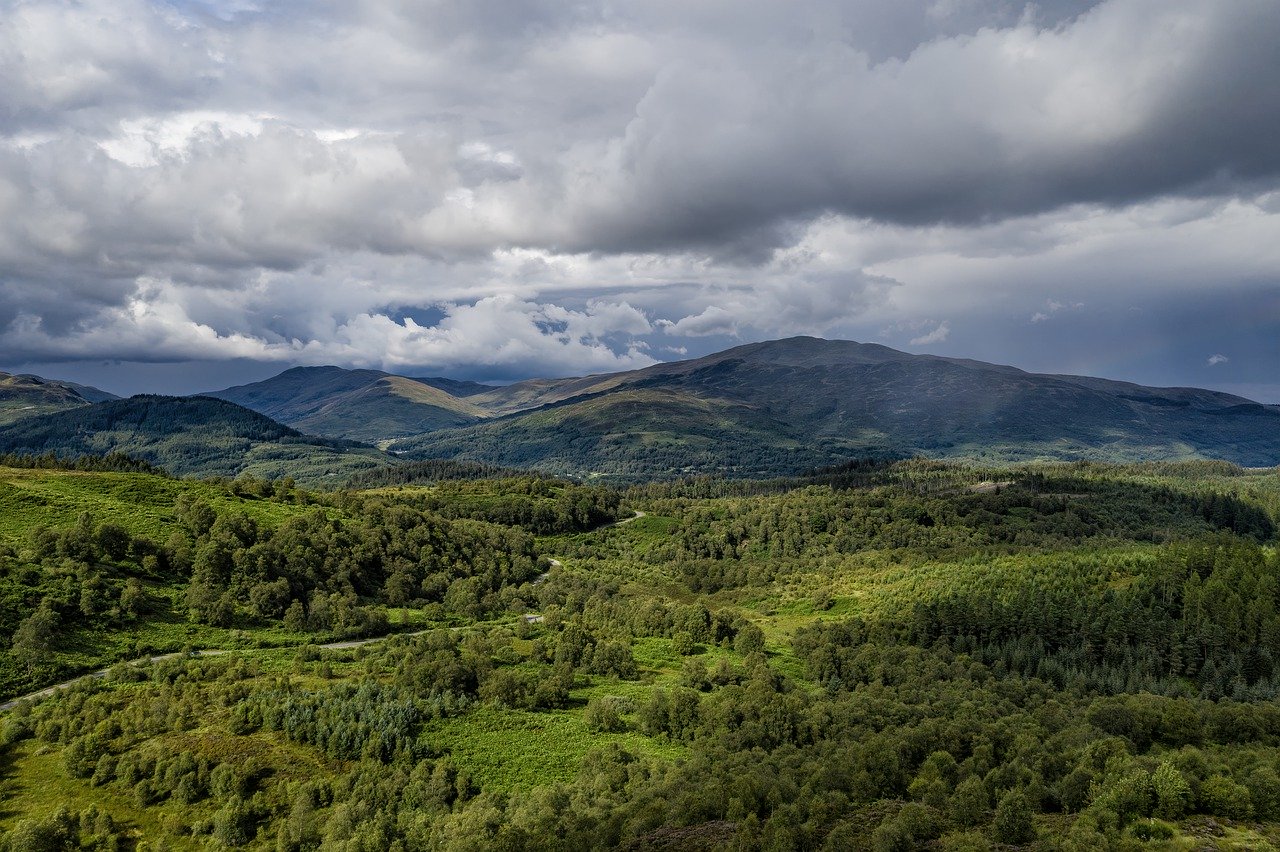
The alarming rate of carbon dioxide flowing into our atmosphere is affecting plant life in interesting ways – but perhaps not in the way you’d expect.
Despite large losses of vegetation to land clearing, drought and wildfires, carbon dioxide is absorbed and stored in vegetation and soils at a growing rate.
This is called the “land carbon sink”, a term describing how vegetation and soils around the world absorb more carbon dioxide from photosynthesis than they release. And over the past 50 years, the sink (the difference between uptake and release of carbon dioxide by those plants) has been increasing, absorbing at least a quarter of human emissions in an average year.


The sink is getting larger because of a rapid increase in plant photosynthesis, and our new research shows rising carbon dioxide concentrations largely drive this increase.
So, to put it simply, humans are producing more carbon dioxide. This carbon dioxide is causing more plant growth, and a higher capacity to suck up carbon dioxide. This process is called the “carbon dioxide fertilisation effect” – a phenomenon when carbon emissions boost photosynthesis and, in turn, plant growth.
What we didn’t know until our study is just how much the carbon dioxide fertilisation effect contributes to the increase in global photosynthesis on land.


But don’t get confused, our discovery doesn’t mean emitting carbon dioxide is a good thing and we should pump out more carbon dioxide, or that land-based ecosystems are removing more carbon dioxide emissions than we previously thought (we already know how much this is from scientific measurements).
And it definitely doesn’t mean mean we should, as climate sceptics have done, use the concept of carbon dioxide fertilisation to downplay the severity of climate change.
Rather, our findings provide a new and clearer explanation of what causes vegetation around the world to absorb more carbon than it releases.
What’s more, we highlight the capacity of vegetation to absorb a proportion of human emissions, slowing the rate of climate change. This underscores the urgency to protect and restore terrestrial ecosystems like forests, savannas and grasslands and secure their carbon stocks.
And while more carbon dioxide in the atmosphere does allow landscapes to absorb more carbon dioxide, almost half (44%) of our emissions remain in the atmosphere.
More carbon dioxide makes plants more efficient
Since the beginning of the last century, photosynthesis on a global scale has increased in nearly constant proportion to the rise in atmospheric carbon dioxide. Both are now around 30% higher than in the 19th century, before industrialisation began to generate significant emissions.
Carbon dioxide fertilisation is responsible for at least 80% of this increase in photosynthesis. Most of the rest is attributed to a longer growing season in the rapidly warming boreal forest and Arctic.

Ecosystems such as forests act as a natural weapon against climate change by absorbing carbon from the atmosphere.
So how does more carbon dioxide lead to more plant growth anyway?
Higher concentrations of carbon dioxide make plants more productive because photosynthesis relies on using the sun’s energy to synthesise sugar out of carbon dioxide and water. Plants and ecosystems use the sugar both as an energy source and as the basic building block for growth.
When the concentration of carbon dioxide in the air outside a plant leaf goes up, it can be taken up faster, super-charging the rate of photosynthesis.
More carbon dioxide also means water savings for plants. More carbon dioxide available means pores on the surface of plant leaves regulating evaporation (called the stomata) can close slightly. They still absorb the same amount or more of carbon dioxide, but lose less water.
The resulting water savings can benefit vegetation in semi-arid landscapes that dominate much of Australia.
We saw this happen in a 2013 study, which analysed satellite data measuring changes in the overall greenness of Australia. It showed more leaf area in places where the amount of rain hadn’t changed over time. This suggests water efficiency of plants increases in a carbon dioxide-richer world.
Young forests help to capture carbon dioxide
In other research published recently, we mapped the carbon uptake of forests of different ages around the world. We showed forests regrowing on abandoned agricultural land occupy a larger area, and draw down even more carbon dioxide than old-growth forests, globally. But why?

Young forests need carbon to grow, so they’re a significant contributor to the carbon sink. Credit: Shutterstock
In a mature forest, the death of old trees balances the amount of new wood grown each year. The old trees lose their wood to the soil and, eventually, to the atmosphere through decomposition.
A regrowing forest, on the other hand, is still accumulating wood, and that means it can act as a considerable sink for carbon until tree mortality and decomposition catch up with the rate of growth.
This age effect is superimposed on the carbon dioxide fertilisation effect, making young forests potentially very strong sinks.
In fact, globally, we found such regrowing forests are responsible for around 60% of the total carbon dioxide removal by forests overall. Their expansion by reforestation should be encouraged.
Forests are important to society for so many reasons – biodiversity, mental health, recreation, water resources. By absorbing emissions they are also part of our available arsenal to combat climate change. It’s vital we protect them.![]()
This article is republished from The Conversation under a Creative Commons license. Read the original article.


18th February 2020 at 11:21 am
Poor Carlo. Forgive him as he knows not what science does.
14th February 2020 at 5:59 pm
Congratulations on a fair scientific article. Such articles are rare, so very often being suppressed, even by CSIRO.
A corollary is, of course, that logging (selective) in mature forests increases carbon dioxide absorption, due to the re-growth replacement effect, as long as the logged timber is properly used (i.e. not burnt or otherwise allowed to decompose).
The next step is to apply the same science/research to the Great Barrier Reef. The GBR consists of a massive foundation built up from the skeletons of dead coral and partly covered by a veneer of living coral. As the living coral dies, its skeletons add to the vast foundation. When sea level rises the living veneer grows on top of the foundation. When sea level falls, the living veneer expands on the perimeter of the reef. When global warming or global cooling predominates, the veneer will expand in a southerly or northerly direction accordingly. The accumulating foundation of coral skeletons is essentially composed of calcium carbonate, which is composed of 44% carbon dioxide!
So Queenslanders, get with it and put the GBR to work and stop whinging about climate change damaging the reef.
12th February 2020 at 2:13 pm
Your statement 44% of anthropogenic CO2 remains in the atmosphere is incorrect. For it to be true 44% of natural CO2 input would also have to remain in the atmosphere. Nature cannot distinguish where CO2 originates from therefore must treat all CO2 equally as must scientists. See Einsteins Equivalence Principle. Now IPCC has annual CO2 input at 100ppm (natural & anthropogenic). Your statement would mean atmospheric CO2 levels would rise at a rate of 44ppm per year. Clearly this is incorrect.
12th February 2020 at 11:03 am
To me, this highlights the complexity of the C02/water cycle related to CC. A complexity which easily allows ‘cherry picking’ of information to suit ones agenda. Media organisations will summarise this article to suit their readers.
Simple, one line quotes suit those who are after the 30sec news time slot. Sadly, few will take the time to absorb the whole article.
11th February 2020 at 4:10 pm
I think that more evidence is required for climate change before we destroy our industries and kill off many jobs, how will people survive as a community without jobs. I believe that we need to look after the environment in a proper controlled way and not by telling lies about CO2, CO2 is 0.03% of the worlds atmosphere and I don’t believe that science has made their case but rather trying to scare people into believing what others want them to believe. Carbon dioxide is being used to change the financial status of countries as in the beginning it was all about carbon trading and nothing to do with the climate, why do we have to pay the world government Billions of dollars under the Paris agreement if it is not about the money. I think that Science has fallen into a trap making people believe that there is climate change for the benefit of the world order and they have fallen for it.
I still have not seen any real science that backs the climate change theory. I have a holiday house that has a jetty in the back yard which leads to tidal water and I have had this for 30 years, the level of the jetty is still the same as it was 30 years ago, where is the sea level rising?? This is why I think Science needs to tell the truth. If we cut all our emissions today it would make no difference at all. I believe that cleaner energy is necessary but what is science doing about it? Why are we giving billions of dollars to Europe instead of using this money find new energy forms, so I think Science should stop talk rubbish about the environment and do what Scientists do find solutions. I am for protecting the environment with what we can do now not talk about kicking Australian industries out and into countries that don’t do anything to help the environment. I conclusion Science needs to stop talk Paris and work hard on future technologies and that’s where the money we give to other countries needs to be spent, I am sure the CSIRO could do a lot with that money. But while science keep this rubbish of climate change the government will be forced to give our money away and Science here will have to go begging.